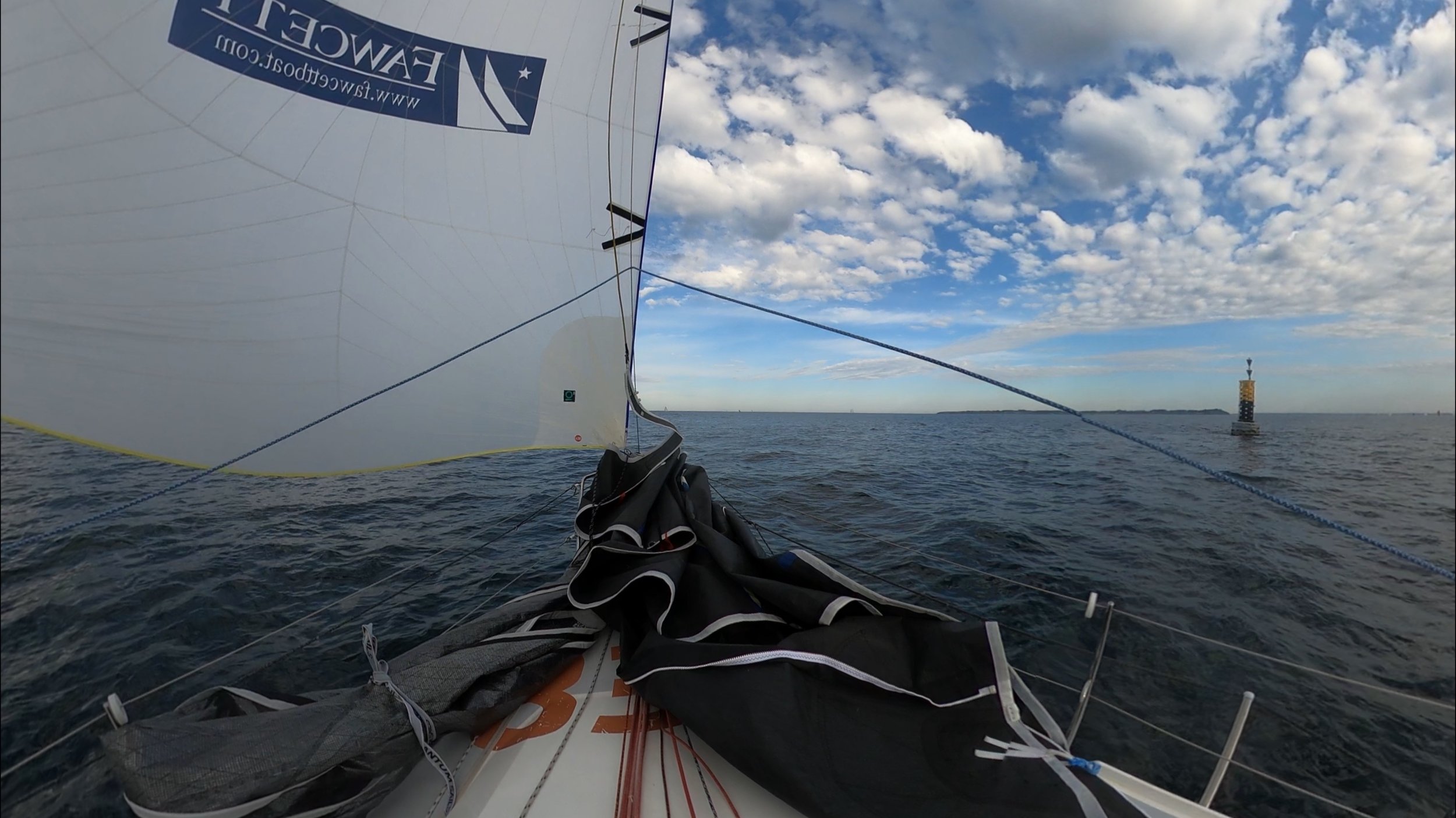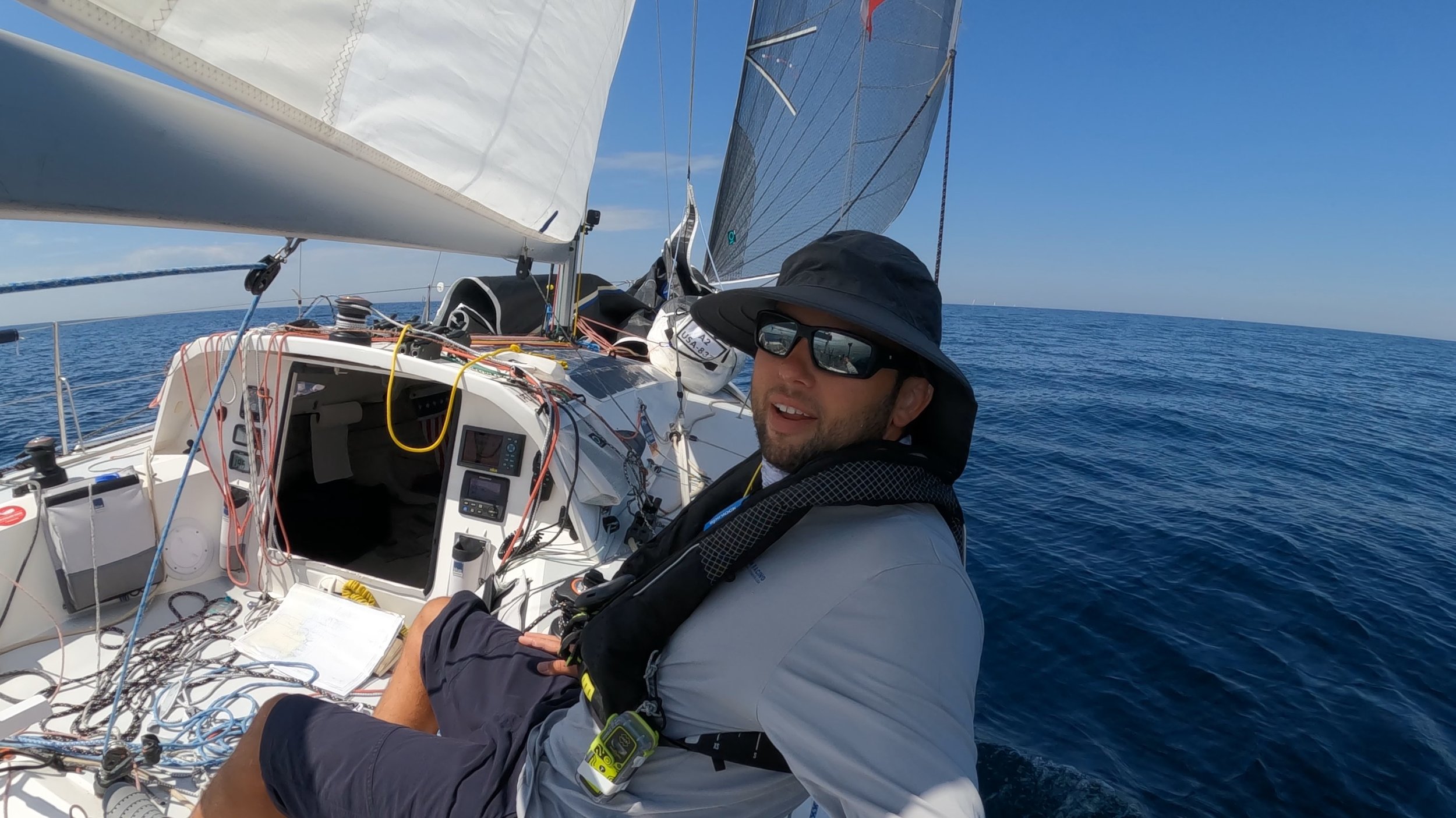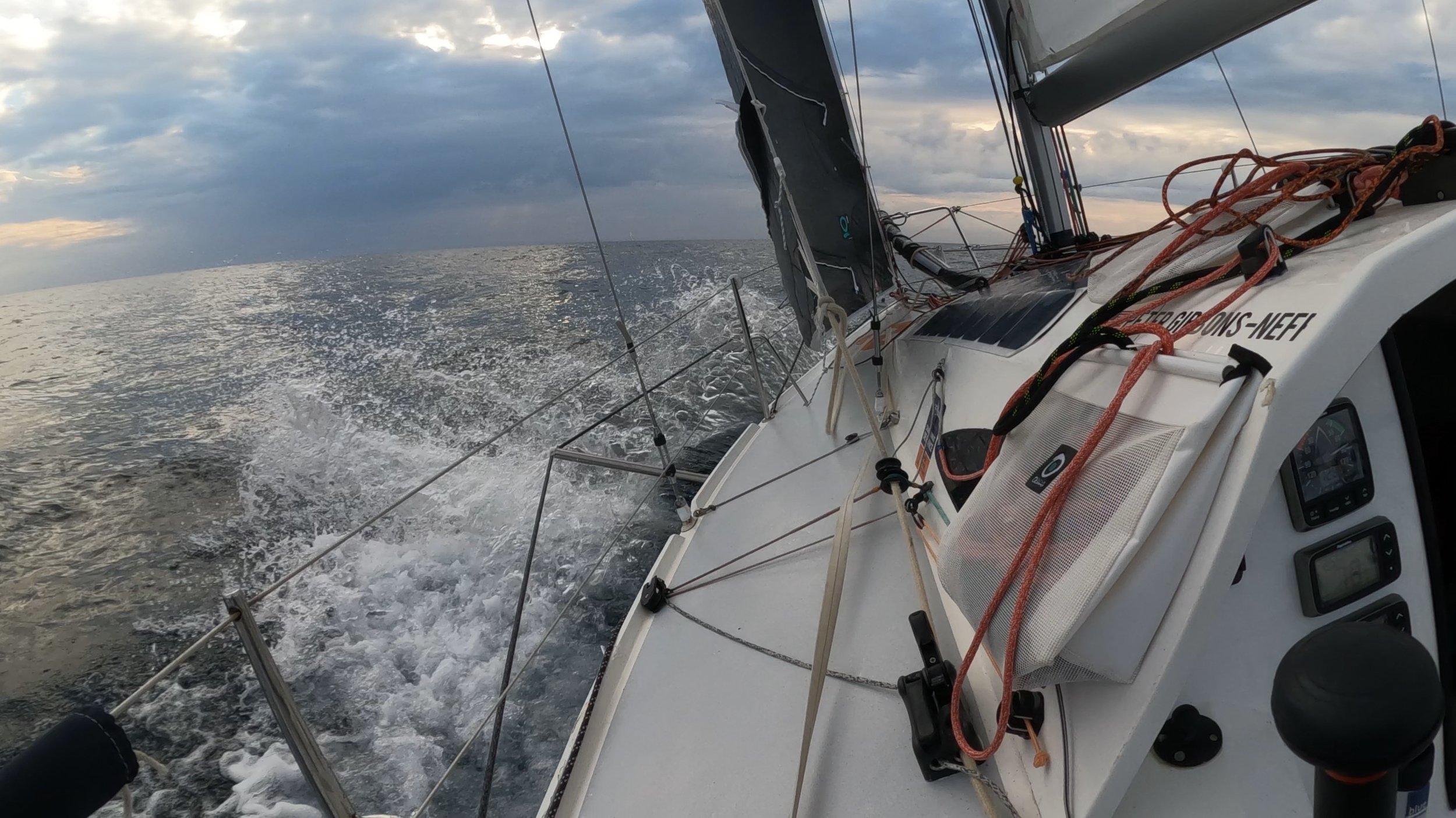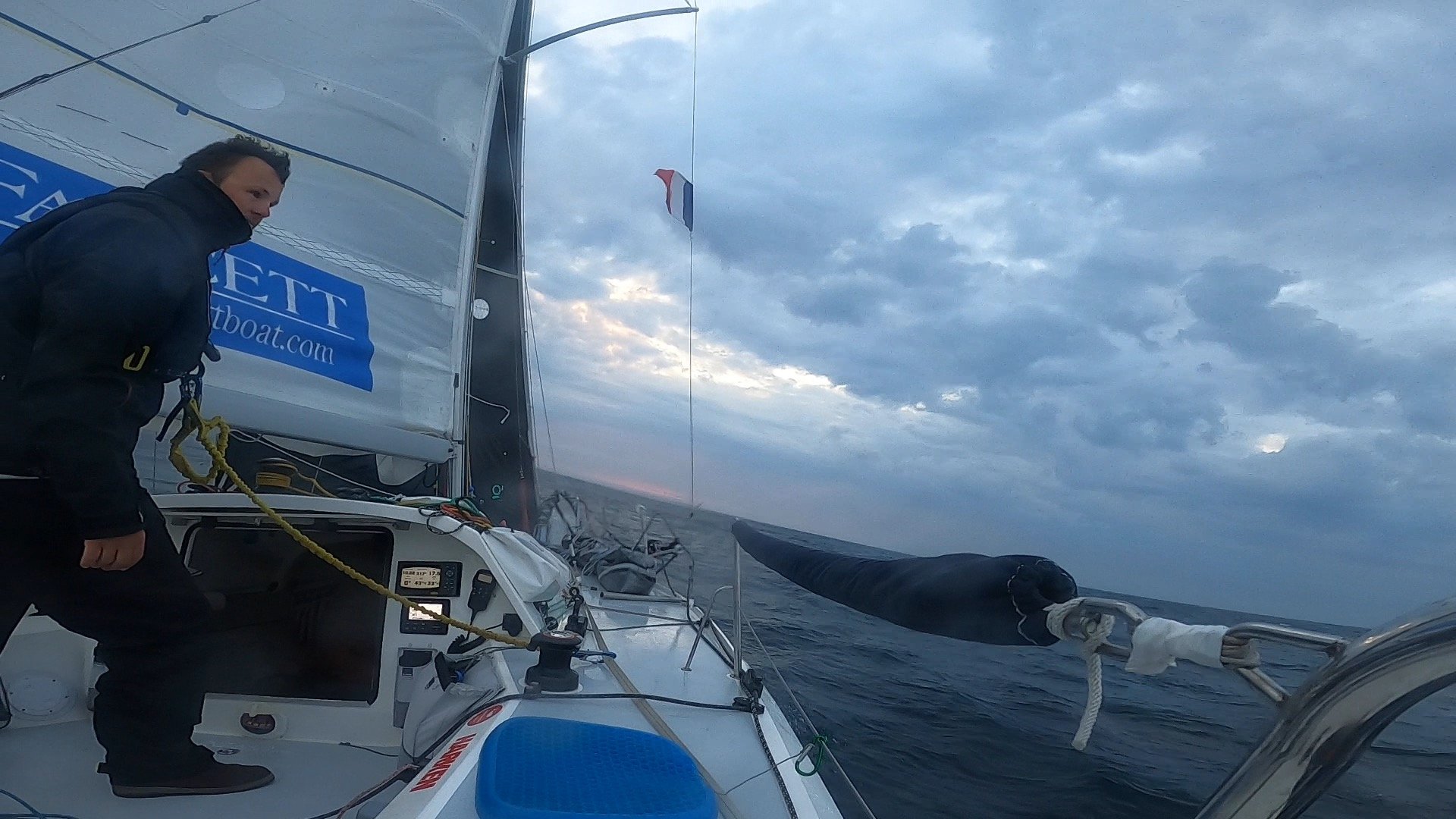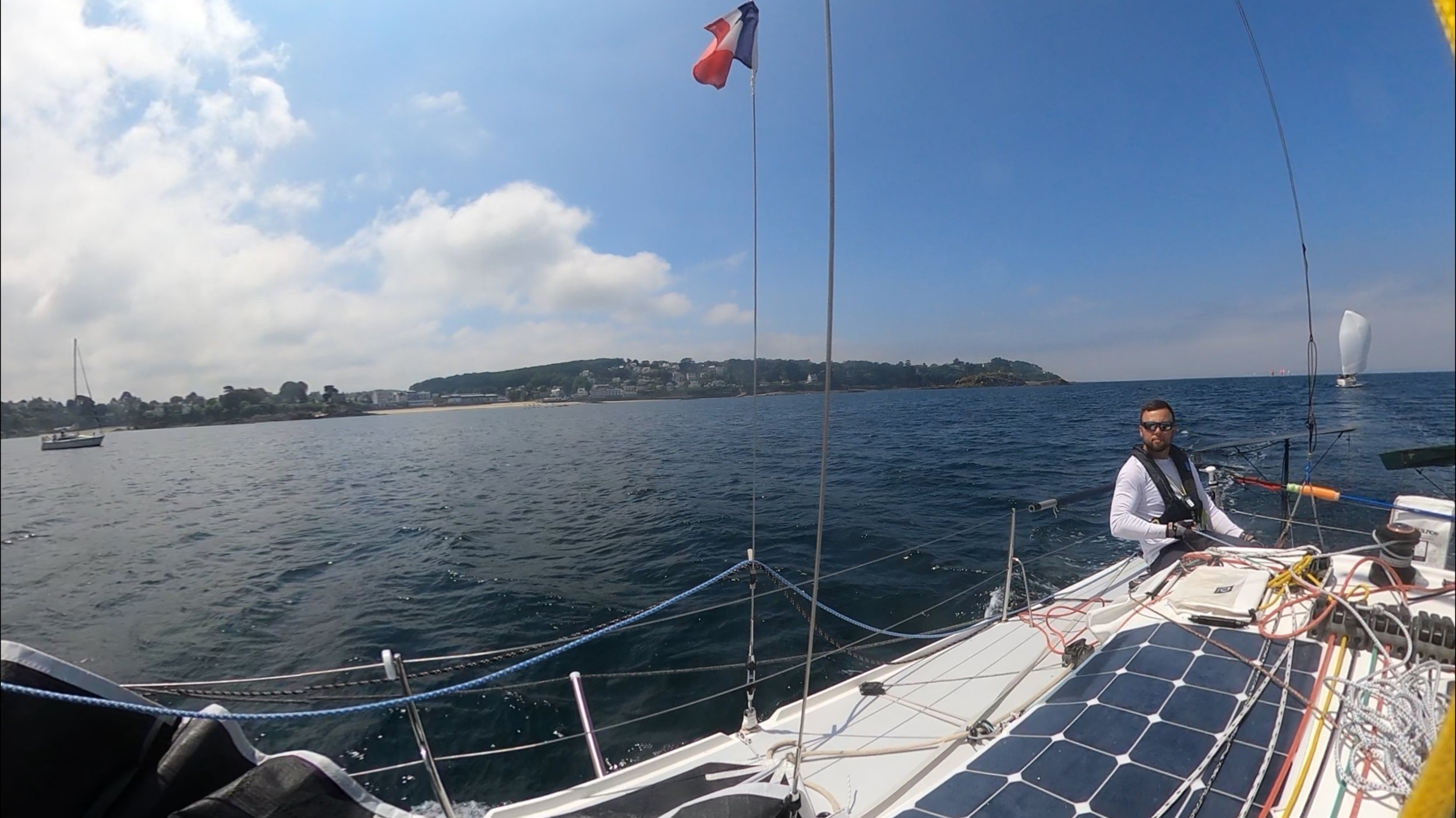MAP After Action Report - Part II
Light conditions, strong current, and a close finish
At about 0830 on the morning of 3 June, I rounded Île de Groix in the Trophée Marie-Agnès Péron (MAP) race. The wind was blowing about ten knots, but softening as the sun rose and air temperature increased.
Rounding Île de Groix and the southern most mark of the course
We started on a beam reach with the spinnaker hoisted. This leg would be almost 80 nm long to round the île de Sein to starboard, then head back into Douarnenez Bay. At 25 nm into the leg, there would be a 30 degree right turn around the Archipel des Glénan (same mark I rounded previously the night before).
By 1100 the main part of the fleet had once again compressed, but we were going slow as the wind dropped. This was all about trying to find the next little bit of pressure with tiny ripples on the surface of the water. Some boats jibed out early and took a more southerly route. This was difficult tactically because I either had to stick with the main pack or try and cover the boats that looked to have slightly more pressure off shore. I tried to jibe at one point for pressure but both angles were not great and I was just in a hole with no wind.
The wind finally started to fill in so I hoisted the Code 0 on a close reach. As I approached the southernmost turning mark for the Archipel des Glénan, the wind continued to rotate and now my part of the fleet was sailing directly upwind against the current. A few tacks in the light air later and I finally made it around the mark. This allowed the boats who had already rounded to gain even more of an advantage.
By 1700, I was on port tack and sailing up wind with a nice 10-12 kts of breeze. I was sitting in 37th place and was 13.5 nm behind the lead boat, both of which I didn’t know with any precision at the time. With 120 nm down, we had 78 nm until the finish. I was not pleased with my current ranking, but was not giving up anytime soon. There was still plenty of opportunities to pass more boats.
On the approach to the marks off the coast of Penmarch, I briefly tacked onto the lifted course offshore. However, the increase in wind and current made the waves choppy and a slow slog upwind. This caused me to tack back inshore. Keep in mind, every time we tack it takes a few minutes to get back up to speed as we adjust and fine tune the sail trim. Additionally, it takes a few more minutes down below moving all of the gear to the new high side and in the appropriate section of the boat to help with the heel/trim angles. Every major increase and decrease in wind velocity will cause me to head down below and move the weight around for ballast and a favorable balance, which leads to more boat speed.
As I advanced towards the coast on port tack, at around 1900 I was considering when to tack with a good lane and within the bigger picture of the race course. The current was still against us, but in the shallower water the waves were less choppy. By the time I tacked, there was only one boat farther inshore, but I was still fairly close to the rocks. Unfortunately, the wind shifted about 15 degrees to the left and so now it felt like I had really over stood the lay line. Only time would tell if the extra distance would pay off with the current relief and we had 34 nm until the next mark.
Hoisted the Code 0 for about 30 minutes
Back to a close hauled course by night fall
At midnight, about 5 hours after rounding the coast of Penmarch, it appeared the extra distance did not really hurt my position, but also didn’t greatly help either. The wind shifted throughout the evening, requiring me to shift from sailing up wind, to reaching with a code 0, and then back to upwind. At this point, I was sailing on a close hauled, starboard tack and aiming at the next mark. It appeared the boats on the right side of the course (where I was) had a better angle throughout this part of the night.
As I approached the southern side if Île de Sein, it was a dark night with about 15 kts of wind. For about 30 minutes I put in the first mainsail reef to reduce the sail area when the wind was at 18 kts and gusts were over 20 kts. There was lightning on the horizon and I was fully expecting a squall to appear at any moment. (While I never saw any precipitation, other boats experienced heavy rain and hail)
Île de Sein is a narrow strip of land (1.5 nm long) and is surrounded by many rocks that sit just under the water throughout the tidal cycle. The hazardous water is 10 nm long and less than 1.5 nm wide. This small island is positioned on the western boundary of the Raz de Sein and can be a dangerous area for mariners.
By 0300 on 4 June, I was around Île de Sein’s western cardinal marker. With the wind and current against me, I had to tack twice just to get around. Layline calls that night were not easy with the tide, shifting wind, and darkness. I rounded in 32nd place, cracked off onto a close reach, and tried to catch my competition.
With 18 nm until the next mark and everyone just off the wind on port tack, I finally had an opportunity to take a few quick naps. I only sleep for about 12 minutes (I have a really loud alarm clock), but rarely do I make it asleep for that long. I easily wake up whenever there is a new noise or the boat feels like it is slowing down. If I take multiple naps in a row, between each one I will take a quick look around visually and at the AIS. Many fishing boats turn off their AIS trackers and have total disregard for sailboats, so they are a serious threat out here.
About 10 nm into this leg, the wind started to shift right. This caused the fleet in my area to once again compress, especially for the boats to the right of my course. As the horizon started to appear and first light approached, the wind softened. I could see boats that I had not seen since the previous morning when the fleet compressed in the light air. This sight gave me a massive boost of energy, and from this moment on I didn’t take my eyes off the sails, instruments, and competition for multiple hours. No time for breakfast or coffee, full inshore race mode until the finish.
After a few tacks, I reached the second to last mark of the course at 0650 that morning in 28th place. I was only 17.5 nm from the finish and with a large group of boats. The leaders had finished at this point, while other boats were still 70 nm back after getting held back with the current. I rounded this mark and hoisted the spinnaker.
This next leg was 7.6 nm long and went from a VMG run down wind, to a reach halfway through. It felt incredible having the boat powered up in about 12 kts of wind, trimming the spinnaker as tight as possible after the wind shift. Terminal Leave loved the angle and I was actually able to pick off a few boats who could not hold the angle. We rounded the last mark of the course in 26th place, dropped the spinnaker, and started to sail upwind.
Last leg of this race! Only 10 nm to go!
In less than half an hour, the wind lightened…eventually dropping to 0 kts. The surface of the water turned to glass and the temperature increased. It started to get real hot. I tried to sail for awhile, even in 2 kts of wind. However, when it was down to nothing, all I could do was drop the jib to prevent the flogging caused by the rocking motion of the small swells.
The wind shut off for about 3 hours in the bay. Around noon, with only 7.6 nm to go until the finish, a new sea breeze started to fill in from the west…very slowly. I hoisted the code 0 and was happy with 0.5 kts of boat speed. During this time, the fleet around me compressed again as the boats farther behind felt the new breeze first.
As the wind increased slightly, it also backed so I changed sails to the A2 spinnaker (my largest sail). I could see a few boats gaining close to the shore south of me, but there was no way I could sail 3.5 nm across a large hole in the wind, when I only had 5 nm until the finish. I didn’t want to lose twenty places now from one final tactical error. So I stuck to my current trajectory in the middle of the bay where I saw pressure.
By 1300, I was the farthest north of a group of 20 boats. I had found myself in this position because I kept following the pressure and tried to connect the puffs. With a slight increase in wind, I was also lifted so I tacked for the angle and to stay in pressure. Farther to the north looked even lighter.
Forty minutes later, I was 2.6 nm from the finish and surrounded by all 20 boats converging. The competition was jibing, playing shifts and pressure, all while trying to cover each other. The wind direction and velocity frequently changed as the new wind tried to establish itself across the bay. This was the closest finish, with the largest number of boats in close proximity I have ever experienced when finishing a distance race. The competition was fierce and everyone was pushing their boats as hard as they could in the 8-10 kts of the sea breeze that now filled in.
Crossing the the finish line with a boat close behind (earlier only 3 boat lengths away)
In the final 2 nm of racing, I was able to hold off a few boats that were close to passing me. The farthest south boats (closest to land) made out the best, but with a few decent tactical calls (and some lucky shifts), I managed to hold off the boats that were in the center of the group.
At 1411 on 4 June I finished the 195 nm race in 1 day, 23 hours, and 17 minutes. Finishing 30th place out of 63 series boats, in such a competitive fleet felt great after the close racing.
One or two different wind shifts throughout the two day race could have put me another fifteen boats ahead, or just as easily fifteen places farther back in the fleet. I was also surprised to have beat eight proto type Minis out of a fleet of fourteen, even with their canting keels, carbon fiber hulls/rigs, and larger sail plans.
Lessons learned
Laylines: Making accurate layline calls around coastal points of land are difficult in shifty winds and strong current, but must be improved upon. Next time I will tack/jibe earlier to make sure I don’t overstand (even if it is less than a mile). Those calls add up!
Stacking Weight: I focused more of my preparation time setting up the boat below deck to more effectively and to quickly stack my gear. This included buying a few more dedicated bags for this purpose. Having this weight as movable ballast and in the most beneficial positions based on weather conditions really helped improve the boat’s performance.
Sleep Management: Every race I still learn a little more about what my body requires for sleep and how hard I can push myself. This race felt like I could plan better on when to sleep based off the different legs and conditions (and a working autopilot helped). After the Mini en Mai race, I was better prepared for the exhaustion when I could not sleep for most of the first night of this race due to proximity of boats.
Boat Speed: In each race Terminal Leave feels a little faster and points slightly higher upwind. Every race is an opportunity to make little adjustments to achieve better performance across different wind speeds and angles.
Route Planning: I felt more confident in my route planning this time, partly because it was a shorter race. With a light wind and a variable forecast, it was not possible to have very accurate weather during parts of the race. For races that will have more steady forecasts, I need to be better prepared for the tactical situations that will develop multiple days into a race.
Stacking the weight down below before the start for a starboard tack
Thank you for reading this blog post! Please share this post with your friends and family.
This racing is only possible with donations from supporters. Want to help my mission to race in the Mini Transat to raise awareness for U.S. Patriot Sailing?
Please donate through my GoFundMe page here: https://gofund.me/1089a37b
Thank you for your support!
Thank you to my sponsors and supporters!



